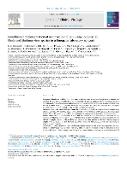Coordinated implementation of a conventional PCR assay to detect all Ebola and Marburg virus species in a European laboratory network

Author
Heimscha, Kim C.
Bleickera, Tobias
Besta, Till Dominik
Presserb, Lance D.
Molenkampc, Richard
Jääskeläinen, Anne J.
Milewska, Alexandra
Baronti, Cécile
Pappa, Sofia
Tabaini, Irena
Cordeiroj, Rita
Marsili, Giulia
Huik, Kristi
Pinho dos Reism, Vincius
Barzon, Luisa
Maes, Piet
Drosten, Christian
Corman, Victor Max
Publication date
2025Published in
Journal of Clinical VirologyVolume / Issue
178 (June)ISBN / ISSN
ISSN: 1386-6532ISBN / ISSN
eISSN: 1873-5967Metadata
Show full item recordCollections
This publication has a published version with DOI 10.1016/j.jcv.2025.105808
Abstract
Background: Filoviruses, including Ebola and Marburg viruses, cause severe hemorrhagic fever in humans and primates. These viruses pose significant threats to public health, making rapid and sensitive detection critical for controlling outbreaks. We developed and validated a hemi-nested generic PanFilo assay to detect all Ebola virus species, Marburg viruses, and recently discovered bat filoviruses. This assay was deployed to 15 European laboratories and evaluated through testing of eight non-infectious samples. Objectives: Laboratories were asked to determine the detection limit of positive controls and test all samples using the assay provided. The deployed assay enables direct Nanopore sequencing of PCR products, by using tagged primers during the second round of PCR. Sequencing of the samples was carried out on a voluntary basis. Results: Multicenter validation revealed a 95 % limit of detection of 5309 RNA copies/mu L for Ebola, 10,273 copies/mu L for Marburg, and 2145 copies/mu L for Mengla virus. In an implementation quality assessment, 93.3 % (84/90) of samples containing filovirus RNA were correctly identified and 100 % (30/30) of filovirus-negative samples were correctly identified. Thirteen laboratories sequenced PCR products, with nine identifying all positive samples correctly. Conclusion: The assay enables rapid and reliable detection of filoviruses, with sequencing capabilities for identifying both known and novel variants. This assay might be used for detection during the initial phase of an emerging filovirus outbreak, before a specific assay has been developed. However, our distribution across 15 laboratories revealed variability challenges due to reagents, human performance, and sequencing capacity, emphasizing the need for more training and standardization.
Keywords
filovirus, nested PCR, diagnostic testing, quality improvement
Permanent link
https://hdl.handle.net/20.500.14178/3116License
Full text of this result is licensed under: Creative Commons Uveďte původ-Neužívejte dílo komerčně 4.0 International







